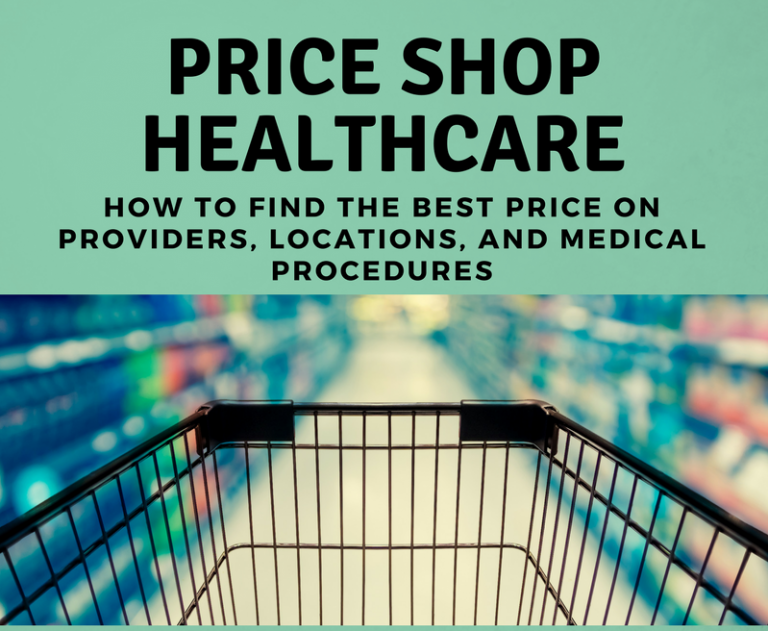
by admin | Mar 28, 2018 | Benefit Management, Benefit Plan Tips, Tricks and Traps, Human Resources
 As the costs of health care soar, many consumers are looking for ways to control their medical spending. Also, with the rise of enrollment in high deductible health plans, consumers are paying for more health care out-of-pocket. From medical savings accounts to discount plans for prescriptions, patients are growing increasingly conscious of prices for their healthcare needs. Price shopping procedures and providers allows you to compare prices so that you are getting the best value for your care.
As the costs of health care soar, many consumers are looking for ways to control their medical spending. Also, with the rise of enrollment in high deductible health plans, consumers are paying for more health care out-of-pocket. From medical savings accounts to discount plans for prescriptions, patients are growing increasingly conscious of prices for their healthcare needs. Price shopping procedures and providers allows you to compare prices so that you are getting the best value for your care.
Why do you need to look beyond your nearby and familiar providers and locations for healthcare? Here’s a hypothetical example: Chris is a 45-year old male in good physical health. During his last check-up he mentions to his doctor that he’s had some recent shortness of breath and has been more tired as of late. His doctor orders an EKG to rule out any problems. If Chris went to his local hospital for this procedure, it would cost $1150. He instead looks online and shops around to find other providers in his area and finds he can get the same procedure for $450 at a nearby imaging center. His potential savings is $700 simply by researching locations.
So where do you start when shopping around for your health care? A good place to begin is by researching your health plan online. Insurance companies will post cost estimates based on facility, physician, and type of procedure. Keep in mind that these are just estimates and may vary based on what coverage you are enrolled in. Another way to shop is by checking out websites that have compiled thousands of claims information for various procedures and locations to give an estimate of costs. However, deciphering whether a site is reporting estimates based on the “medical sticker price” of charges or rates for private insurance plans or Medicare is difficult. There are huge differences in prices at different providers for the exact same procedure. This is because contracts between insurance agencies and providers vary based on negotiated amounts. This makes it hard to get consistent pricing information.
Check out these sites that do a great job comparing apples to apples for providers:
- Healthcare Blue Book
- What Kelly Blue Book is to cars, Healthcare Blue Book is to medical pricing
- New Choice Health
- Reports on pricing of medical procedures, providers, quality of facilities, and customer feedback for healthcare in all 50 states
- The Leapfrog Group
- Publishes data on hospitals so patients can compare facilities and costs for treatments and procedures
After compiling all the information on prices and procedures, you can still call and negotiate costs with the location of your care. Fair Health Consumer has tips on how to negotiate with providers and plan for your healthcare needs.
Knowledge is POWER and when you spend time researching and comparing healthcare costs, you are empowering yourself! Exercising due diligence to plan for you and your family’s medical needs will save you money and give you confidence in your decisions for care.

by admin | Oct 26, 2017 | Benefit Management, Benefit Plan Tips, Tricks and Traps, Human Resources

Fall. With it comes cooler temperatures’, falling leaves, warm seasonal scents like turkey and pumpkin pie, and Open Enrollment. It goes without saying; employees who understand the effectiveness of their benefits are much more pleased with those packages, happier with their employers, and more engaged in their work. So, as your company gears up for a new year of navigating Open Enrollment, here are a few points to keep in mind to make the process smoother for both employees and your benefits department. Bonus: it will lighten the load for both parties alike during an already stress-induced season.
Communicate Open Enrollment Using a Variety of Mediums
Advertise 2018 benefit changes to employees by using a variety of mediums. The more reminders and explanation of benefits staff members have using more than one mode of media, the more likely employees will go into Open Enrollment with more knowledge of your company’s benefit options and when they need to have these options completed for the new year.
- Consider explainer videos to simplify the amount of emails and paperwork individuals need to review come Open Enrollment time. These videos can increase the bottom line as well, eliminating the high cost of print material.
- Opt for placards placed throughout your high-traffic areas. Communicate benefit options and remind employees of Open Enrollment dates for the new year by posting in such areas as the lobby, break room and bathroom stalls.
- Choose SMS texting. Today, over 97% of individuals use text. Ninety-eight percent of those that use text open messages within the first three minutes of receiving them; 6-8 times higher than the engagement rate for email. Delivering a concise message to employees’ mobile devices creates more touch points along the Open Enrollment journey. The key, however, is making it quick so as to entice your employees to take action.
- Promote apps and in-app tools. Push notifications and apps like Remind 101 can help drive employee engagement during Open Enrollment season simply by providing short messages reminding them to enroll. Notifications like these can also be tailored to unique employee groups based on location, job level, eligibility status and more.
Utilize Mobile Apps and Web Portals for Open Enrollment
Now that your company has communication down pat for Open Enrollment, simplify the arduous task employees have of enrolling for the coming year by going paperless. Utilize web portals through benefit brokers and companies like ADP to eliminate the hassle of employees having to fill out paperwork both at renewal, and at the time of hire. With nearly three quarters of individuals in the United States checking their phone once an hour and 90% percent of this time is spent using one app or another as a main source of communication, mobile apps can make benefits engagement much easier due to the anywhere/anytime accessibility they offer.
The personal perks for employees are great too! Staff members with a major lifestyle event can make benefit adjustments quickly with the ease of mobile apps. Employees recognize this valuable and time-saving trend and enjoy having this information at their fingertips.
Open Enrollment season can be a stressful time but hopefully these tips will help for a smoother transition into the next year for your business. Simple things like using explainer videos, placing reminders in high traffic areas and utilizing mobile apps and text messaging can save time and stress in the long run for your employees and benefit department.

by admin | Sep 27, 2017 | Benefit Plan Tips, Tricks and Traps, Employee Benefits, Human Resources
 We’ve all been there – once or twice (or more)—when a child, spouse or family member has had to gain access to healthcare quickly. Whether a fall that requires stitches; a sprained or broken bone; or something more serious, it can be difficult to identify which avenue to take when it comes to walk-in care. With the recent boom in stand-alone ERs (Emergency Care Clinics or ECCs), as well as, Urgent Care Clinics (UCCs) it’s easy to see why almost 50% of diagnoses could have been treated for less money and time with the latter.
We’ve all been there – once or twice (or more)—when a child, spouse or family member has had to gain access to healthcare quickly. Whether a fall that requires stitches; a sprained or broken bone; or something more serious, it can be difficult to identify which avenue to take when it comes to walk-in care. With the recent boom in stand-alone ERs (Emergency Care Clinics or ECCs), as well as, Urgent Care Clinics (UCCs) it’s easy to see why almost 50% of diagnoses could have been treated for less money and time with the latter.
It’s key to educate yourself and your employees on the difference between the two so as not to get pummeled by high medical costs.
- Most Emergency Care facilities are open 24 hours a day; whereas Urgent Care may be open a maximum of 12 hours, extending into late evening. Both are staffed with a physician, nurse practitioners, and physician assistants, however, stand alone ECCs specialize in life-threatening conditions and injuries that require more advanced technology and highly trained medical personnel to diagnose and treat than a traditional Urgent Care clinic.
- Most individual ERs charge a higher price for the visit – generally 3-5 times higher than a normal Urgent Care visit would cost. The American Board of Emergency Medicine (ABEM) physicians’ bill at a higher rate than typical Family-Medicine trained Urgent Care physicians do (American Board of Family Medicine (ABFM). These bill rates are based on insurance CPT codes. For example, a trip to the neighborhood ER for strep throat may cost you more than a visit to a UC facility. Your co-insurance fee for a sprain or strain at the same location may cost you $150 in lieu of $40 at a traditional Urgent Care facility.
- Stand alone ER facilities may often be covered under your plan, but some of the “ancillary” services (just like visit rates) may be billed higher than Urgent Care facilities. At times, this has caused many “financial sticker shock” when they first see those medical bills. The New England Journal of Medicine indicates 1 of every 5 patients experience this sticker shock. In fact, 22% of the patients who went to an ECC covered by their insurance plan later found certain ancillary services were not covered, or covered for less. These services were out-of-network, therefore charged a higher fee for the same services offered in both facilities.
So, what can you and your employees do to make sure you don’t get duped into additional costs?
- Identify the difference between when you need urgent or emergency care.
- Know your insurance policy. Review the definition of terms and what portion your policy covers with regard to deductibles and co-pays for each of these facilities.
- Pay attention to detail. Understand key terms that define the difference between these two walk-in clinics. Most Emergency Care facilities operate as stand-alone ERs, which can further confuse patients when they need immediate care. If these centers, or their paperwork, has the word “emergency”, “emergency” or anything related to it, they’ll operate and bill like an ER with their services. Watch for clinics that offer both services in one place. Often, it’s very easy to disguise their practices as an Urgent Care facility, but again due to CPT codes and the medical boards they have the right to charge more. Read the fine print.
It’s beneficial as an employer to educate your employees on this difference, as the more they know – the lower the cost will be for the employer and employee come renewal time.

by admin | Jul 7, 2017 | Benefit Plan Tips, Tricks and Traps, Employee Benefits, Human Resources
 Many employers have invested in benefits administration systems to streamline their processes and connectivity with payroll systems as well as external vendors. From an efficiency and reporting perspective, this works wonderfully. However, when it comes to leveraging that technology for open enrollment and benefits communication, there can be gaps that limit effectiveness.
Many employers have invested in benefits administration systems to streamline their processes and connectivity with payroll systems as well as external vendors. From an efficiency and reporting perspective, this works wonderfully. However, when it comes to leveraging that technology for open enrollment and benefits communication, there can be gaps that limit effectiveness.
Our recent survey found that while technology plays a big role (47 percent of surveyed employees used a platform to enroll in their benefits), only 15 percent used an online tool to learn about their options. The good news is that of those who sought information, 90 percent found that interactive digital experience to be helpful.
The question then is, how do we encourage employees to seek information about the benefits available to them?
In a previous blog post, we talked about the power of personalization. Employees want the ability to customize their benefits package to meet their needs. This can seem challenging if your enrollment experience is limited to a simple (or overly complex) menu of benefits, only accompanied by the ability to elect participate, or waive (some may include links to product information). From a data perspective, this can be a seamless HR experience—but is it a great experience for employees?
There are several ways to create a better employee experience and your UBA advisors and vendor partners can help.
When you are planning your next open enrollment, ask your benefits administration partner what, if any, benefits communication tools they may have. Some platforms have started to incorporate dynamic video and animated presentations that help personalize the enrollment experience. Highlight these tools to your employees as part of the pre-enrollment communication package.
Insurance providers and other vendors are also great resources. Insurers may have product calculators to help employees determine coverage amounts that make sense for them. They may also have videos as well as single sign-on links that provide employees additional information. The same types of tools may be available from other vendors, such as health savings account (HSA) administrators.
Consider one-to-one employee meetings with a benefits counselor. Eighty-six percent of surveyed employees said they want a clearer explanation of benefits choices, and 80 percent want one-on-one time. Remember, your employees learn differently, and many could benefit from having a personal conversation about their needs. In many cases, it is possible to work with a carrier, or vendor, that can actually conduct the meetings and enroll employees on the benefits administration platform. The one-on-one meetings help employees learn about options specific to their circumstances, and the on-site representative can help guide them on how to use the system. This can also be an opportunity to update employee information such as dependents, beneficiaries, and contact information.
Successfully blending personalized benefits communication strategies with benefits administration technology can help increase employee engagement and streamline your processes.
By Kevin D. Seeker
Originally Posted By www.ubabenefits.com

by admin | Jun 13, 2017 | Benefit Plan Tips, Tricks and Traps, Human Resources
 The Section 125 cafeteria plan regulations and the Patient Protection and Affordable Care Act (ACA) require employers to take certain actions when an employee reduces hours.
The Section 125 cafeteria plan regulations and the Patient Protection and Affordable Care Act (ACA) require employers to take certain actions when an employee reduces hours.
Consider this scenario: An employer has an employee who is reducing hours below 30 hours per week. The employee is performing the same job and duties. The employee was determined to be full-time during the most recent measurement period. The employee is currently in a stability period.
What happens when the employee reduces hours during a stability period?
Answer: The employee must be offered coverage through the entire stability period. The employee must remain classified as full-time for the rest of the stability period. An employee’s full-time status determined in the measurement period determines the employee’s status during the subsequent stability period. This is true regardless of why the individual’s hours were reduced, or who chose to reduce the hours.
By Danielle Capilla
Originally Posted By www.ubabenefits.com

by admin | Mar 15, 2017 | ACA, Benefit Plan Tips, Tricks and Traps, COBRA, Compliance, Medicare
 Our Firm is making a big push to provide compliance assessments for our clients and using them as a marketing tool with prospects. Since the U.S. Department of Labor (DOL) began its Health Benefits Security Project in October 2012, there has been increased scrutiny. While none of our clients have been audited yet, we expect it is only a matter of time and we want to make sure they are prepared.
Our Firm is making a big push to provide compliance assessments for our clients and using them as a marketing tool with prospects. Since the U.S. Department of Labor (DOL) began its Health Benefits Security Project in October 2012, there has been increased scrutiny. While none of our clients have been audited yet, we expect it is only a matter of time and we want to make sure they are prepared.
We knew most fully insured groups did not have a Summary Plan Description (SPD) for their health and welfare plans, but we have been surprised by some of the other things that were missing. Here are the top five compliance surprises we found.
- COBRA Initial Notice. The initial notice is a core piece of compliance with the Consolidated Omnibus Budget and Reconciliation Act (COBRA) and we have been very surprised by how many clients are not distributing this notice. Our clients using a third-party administrator (TPA), or self-administering COBRA, are doing a good job of sending out the required letters after qualifying events. However, we have found that many clients are not distributing the required COBRA initial notice to new enrollees. The DOL has recently updated the COBRA model notices with expiration dates of December 31, 2019. We are trying to get our clients to update their notices and, if they haven’t consistently distributed the initial notice to all participants, to send it out to everyone now and document how it was sent and to whom.
- Prescription Drug Plan Reporting to CMS. To comply with the Medicare Prescription Drug Improvement and Modernization Act, passed in 2003, employer groups offering prescription benefits to Medicare-eligible individuals need to take two actions each year. The first is an annual report on the Centers for Medicare & Medicaid Services (CMS) website regarding whether the prescription drug plan offered by the group is creditable or non-creditable. The second is distributing a notice annually to Medicare-eligible plan members prior to the October 15 beginning of Medicare open enrollment, disclosing whether the prescription coverage is creditable or non-creditable. We have found that the vast majority (but not 100 percent) of our clients are complying with the second requirement by annually distributing notices to employees. Many clients are not complying with the first requirement and do not go to the CMS website annually to update their information. The annual notice on the CMS website must be made within:
- 60 days after the beginning of the plan year,
- 30 days after the termination of the prescription drug plan, or
- 30 days after any change in the creditability status of the prescription drug plan.
- ACA Notice of Exchange Rights. The Patient Protection and Affordable Care Act (ACA) required that, starting in September 2013, all employers subject to the Fair Labor Standards Act (FLSA) distribute written notices to all employees regarding the state exchanges, eligibility for coverage through the employer, and whether the coverage was qualifying coverage. This notice was to be given to all employees at that time and to all new hires within 14 days of their date of hire. We have found many groups have not included this notice in the information they routinely give to new hires. The DOL has acknowledged that there are no penalties for not distributing the notice, but since it is so easy to comply, why take the chance in case of an audit?
- USERRA Notices. The Uniformed Services Employment and Reemployment Rights Act (USERRA) protects the job rights of individuals who voluntarily or involuntarily leave employment for military service or service in the National Disaster Medical System. USERRA also prohibits employers from discriminating against past and present members of the uniformed services. Employers are required to provide a notice of the rights, benefits and obligations under USERRA. Many employers meet the obligation by posting the DOL’s “Your Rights Under USERRA” poster, or including text in their employee handbook. However, even though USERRA has been around since 1994, we are finding many employers are not providing this information.
- Section 79. Internal Revenue Code Section 79 provides regulations for the taxation of employer-provided life insurance. This code has been around since 1964, and while there have been some changes, the basics have been in place for many years. Despite the length of time it has been in place, we have found a number of groups that are not calculating the imputed income. In essence, if an employer provides more than $50,000 in life insurance, then the employee should be paying tax on the excess coverage based on the IRS’s age rated table 2-2. With many employers outsourcing their payroll or using software programs for payroll, calculating the imputed income usually only takes a couple of mouse clicks. However, we have been surprised by how many employers are not complying with this part of the Internal Revenue Code, and are therefore putting their employees’ beneficiaries at risk.
There have been other surprises through this process, but these are a few of the more striking examples. The feedback we received from our compliance assessments has been overwhelmingly positive. Groups don’t always like to change their processes, but they do appreciate knowing what needs to be done.
By Bob Bentley, Originally Published By United Benefit Advisors

 As the costs of health care soar, many consumers are looking for ways to control their medical spending. Also, with the rise of enrollment in high deductible health plans, consumers are paying for more health care out-of-pocket. From medical savings accounts to discount plans for prescriptions, patients are growing increasingly conscious of prices for their healthcare needs. Price shopping procedures and providers allows you to compare prices so that you are getting the best value for your care.
As the costs of health care soar, many consumers are looking for ways to control their medical spending. Also, with the rise of enrollment in high deductible health plans, consumers are paying for more health care out-of-pocket. From medical savings accounts to discount plans for prescriptions, patients are growing increasingly conscious of prices for their healthcare needs. Price shopping procedures and providers allows you to compare prices so that you are getting the best value for your care.




